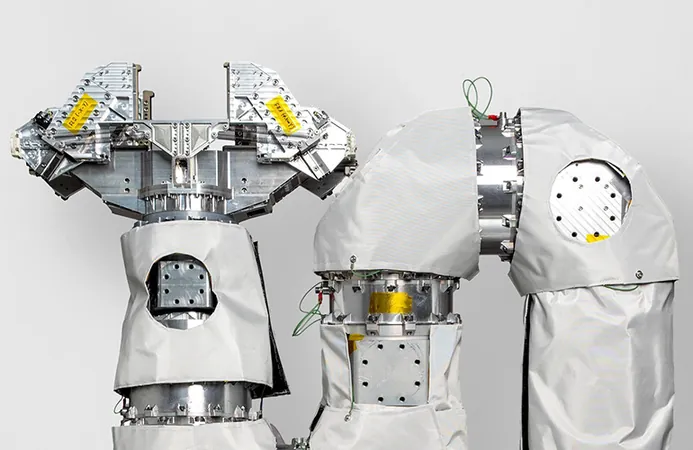
Meet TITAN: The Game-Changer Robotic Arm Revolutionizing Satellite Maintenance
2025-04-11
Author: Yu
Revolutionizing Orbital Operations with TITAN
In an exciting leap for space technology, Polish innovator PIAP Space Sp. z o.o. has unveiled the TITAN robotic arm, designed to transform how we maintain and operate satellites in the increasingly crowded realms of Earth's orbit. This state-of-the-art technology promises to slash the time and costs associated with caring for multimillion-dollar satellites.
Solving the Space Junk Crisis
As the satellite industry booms, our skies are becoming cluttered with both active and defunct spacecraft. This congestion raises serious risks for operational satellites, which can malfunction due to failure in just one component. Currently, the only recourse without robotics is to deorbit and replace these satellites, compounding the issue of space debris and driving up mission costs.
Recognizing this critical challenge, both the European Space Agency (ESA) and the global space sector have identified autonomous in-orbit servicing (IOS) as a crucial priority.
TITAN: A Technological Marvel
TITAN stands as a testament to PIAP Space's innovative prowess. "It's the most advanced robotic manipulator of its kind developed in Poland, and potentially one of the most capable in Europe," says Paweł Paśko, head of the mechatronics section at PIAP Space. Designed for versatility, scalability, and adaptability, TITAN is equipped to tackle various missions both in orbit and beyond, including those on the Moon.
With a reach of 2 meters (6.5 feet) and seven degrees of freedom, TITAN offers extraordinary precision—achieving sub-millimeter accuracy in positioning.
Engineered for Excellence
Each joint of the TITAN robotic arm features a redundant architecture ensuring continuous performance. Equipped with independent power lines and data buses, the arm is designed to overcome potential systemic failures.
Its flexible modular design means it can be outfitted with a range of custom end effectors, from multipurpose grippers to advanced sensors. This adaptability allows the arm to be reconfigured swiftly for various tasks, from satellite repairs to intricate construction operations in microgravity.
Preparing for the Future of Space Servicing
Funded by ESA through a €2.6 million ($2.9 million USD) contract, TITAN has reached a significant milestone with Technology Readiness Level 6 (TRL 6), demonstrating its operability in simulated orbital conditions. This pivotal step positions TITAN for integration into forthcoming servicing missions.
Supporting the IOSHEX Initiative
In collaboration with ESA and SAB Aerospace, PIAP is also fine-tuning TITAN for the IOSHEX initiative—a groundbreaking project aimed at creating a long-term robotic servicing platform in low Earth orbit. This station will enable tasks such as maintenance and refurbishments.
Designed to remain in orbit for up to five years, the IOSHEX module will serve as a robotic service station, complemented by the ESA Space Rider vehicle, which will ferry components for repairs and return outdated equipment for recycling.
A Legacy of Innovative Exploration
PIAP Space is no stranger to cutting-edge technology; they've previously developed robotic solutions for projects like the ESA ARGONAUT lunar lander and contributed to satellite refueling concepts. Their advancements in modular robotics showcase their expertise and commitment to shaping the future of space exploration.
Catch the TITAN Reveal!
Mark your calendars! PIAP Space will officially present the TITAN prototype during the ESA Space Security Conference in Warsaw on April 14 and 15. You won’t want to miss this unveiling of technology set to redefine satellite maintenance and operations!




 Brasil (PT)
Brasil (PT)
 Canada (EN)
Canada (EN)
 Chile (ES)
Chile (ES)
 Česko (CS)
Česko (CS)
 대한민국 (KO)
대한민국 (KO)
 España (ES)
España (ES)
 France (FR)
France (FR)
 Hong Kong (EN)
Hong Kong (EN)
 Italia (IT)
Italia (IT)
 日本 (JA)
日本 (JA)
 Magyarország (HU)
Magyarország (HU)
 Norge (NO)
Norge (NO)
 Polska (PL)
Polska (PL)
 Schweiz (DE)
Schweiz (DE)
 Singapore (EN)
Singapore (EN)
 Sverige (SV)
Sverige (SV)
 Suomi (FI)
Suomi (FI)
 Türkiye (TR)
Türkiye (TR)
 الإمارات العربية المتحدة (AR)
الإمارات العربية المتحدة (AR)